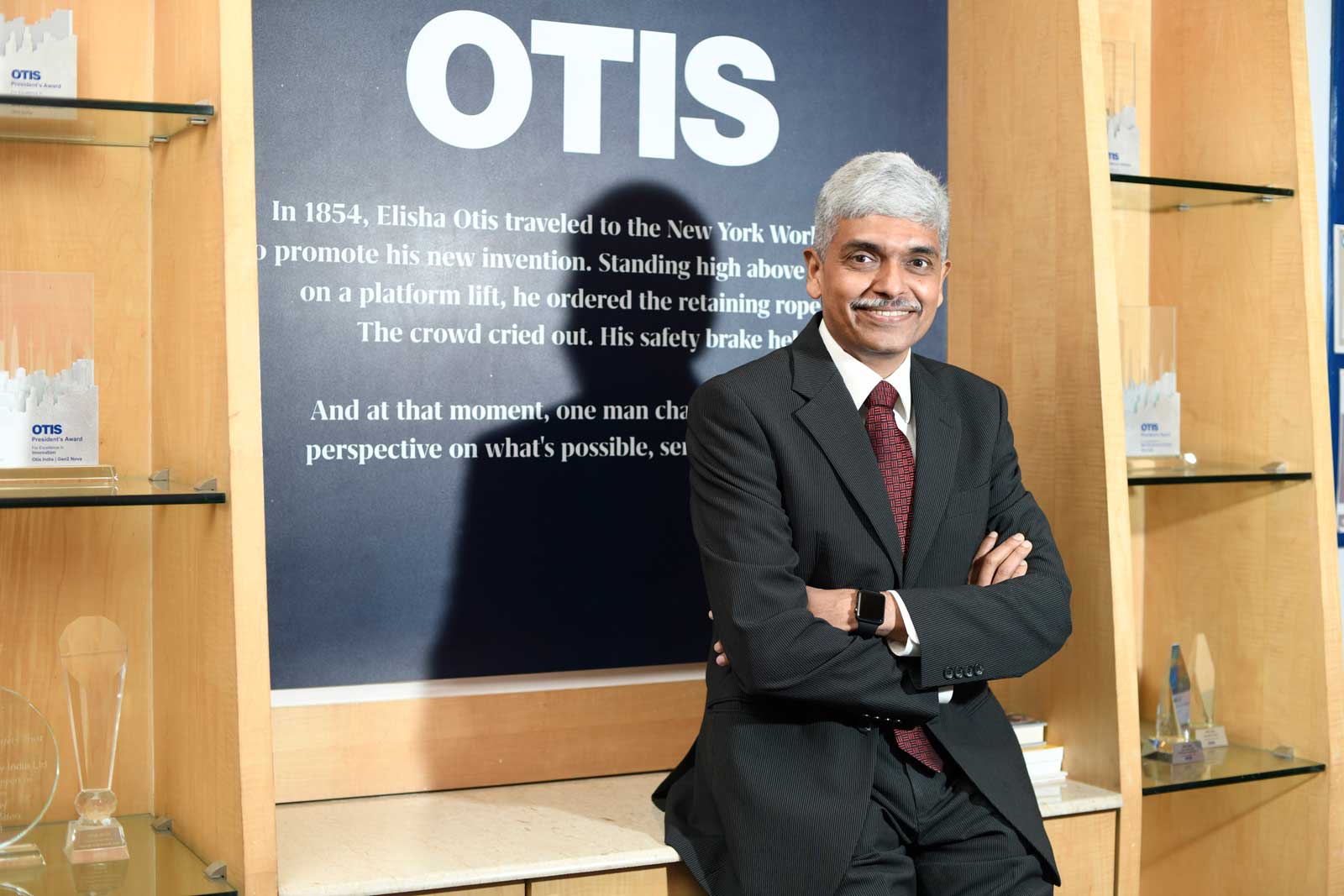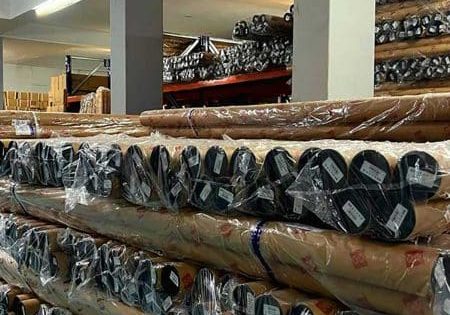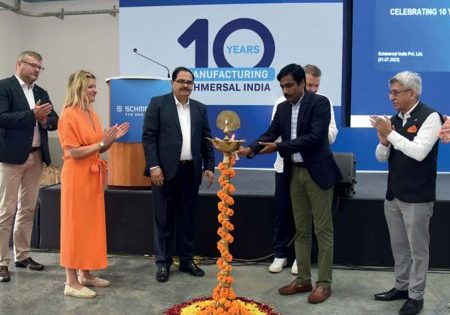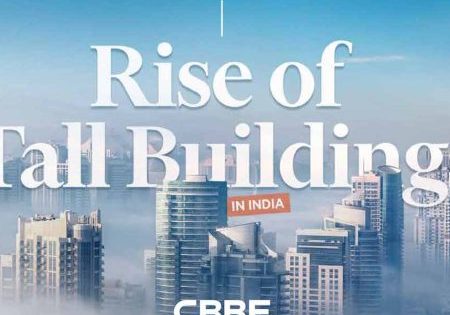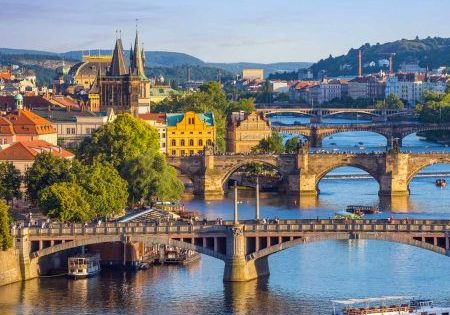Otis India President Sebi Joseph (SJ) provides perspectives to your author (SSP) on key growth drivers elevating the VT industry in India and continuing to provide impetus going forward.
SSP: Describe the key growth drivers elevating the vertical-transportation (VT) industry in India right now. Do you see these drivers continuing to provide impetus going forward?
SJ: The VT industry in India is experiencing significant growth due to several key drivers in the present scenario. One of the prominent growth drivers is urbanization. As urban areas continue to expand rapidly, there is a growing demand for high-rise buildings such as residential apartments, commercial complexes and office spaces. VT systems, including elevators and escalators, are essential for efficient mobility within these tall structures. With the global aging population, VT is even more important for inclusive mobility. Another important factor driving domestic VT industry growth is the increasing adoption of smart technologies. With advancements in automation, connectivity and AI, elevators and escalators are becoming smarter and more energy efficient. These technologies not only enhance passenger safety and convenience, but also enable effective monitoring, predictive maintenance and energy optimization, leading to cost savings and improved sustainability. Additionally, government initiatives and regulations are playing a significant role in boosting the Indian VT industry. The government’s focus on infrastructure development, urban renewal projects and initiatives like the Smart Cities Mission have created a favorable environment for VT sector growth. Regulations and building codes that mandate the installation of VT in high-rise buildings further contribute to demand.
SSP: With skyscrapers and intelligent buildings that necessitate integration of VT systems on a hitherto unprecedented scale on the rise, which new challenges and opportunities do leading OEMs, including Otis India, face?
SJ: There are three primary opportunities today regarding high-rise and intelligent buildings:
- Meeting customer and passenger needs and expectations around connectivity and digitalization,
- Meeting growing demand in medium and smaller cities and
- Coordinating with a fast-moving high-rise market.
Regarding connectivity, developer, building manager and passenger expectations for connectivity and a digital experience continue to evolve and push those in the VT industry to advance our offerings. OEMs have been developing and refining solutions like destination-dispatch systems (including Otis’ Compass™ system) and connectivity to security systems and other traffic-management solutions. Now, digital products and solutions like in-cab displays (such as Otis’ eViewTM) and Internet of Things (IoT) service platforms (such as Otis’ ONETM, which offers connected service benefits and shares data transparently with customers), have come to the forefront. With the help of application programming interfaces (APIs), elevators can be easily integrated into building-management systems.
For passengers, the ability to remotely call an elevator via smartphones (using, for example, the Otis’ eCallTM app) and tenant app integrations have started to gain popularity. Other API connections, including APIs for autonomous robots, are another emerging digital domain in VT. This increased digitalization coincides with the increasing emphasis on sustainability and energy efficiency. Growing opportunity exists for us to develop and offer eco-friendly solutions. The integration of smart technologies and IoT capabilities in elevators and escalators enables better performance monitoring, predictive maintenance and an improved user experience.
“Regarding connectivity, developer, building manager and passenger expectations for connectivity and a digital experience continue to evolve and push those in the VT industry to advance our offerings.”
Regarding demand, we are at the cusp of several new opportunities in the evolving landscape of urban infrastructure in India. The remote working era has led to the migration of many from the working-class population to Tier II and III cities, for example Vizag, Kochi, Patna, Chandigarh and Indore, to name a few, which has led to a boom in residential and commercial projects. With that demand comes the challenge of coordinating with a fast-moving real estate and construction market. One challenge we typically encounter when designing elevators for high-rise buildings is understanding the type of building usage, which sometimes is not available until later stages of design, or even during construction. When we understand this — including the required traffic patterns and demand — we can propose the best elevator solutions using a combination of destination dispatch, double-deck elevators, sky lobbies and more to address any restrictions and efficiently move people.
Such coordination can also help us develop personalized solutions. By understanding and catering to the specific needs of different industries — such as healthcare, hospitality and commercial spaces — Otis India is creating customized products and services to meet customers’ unique requirements through new aesthetic offerings like the Otis Ambiance range and the Otis Create platform to visualize the solution.
SSP: There is a rising emphasis on predictive analysis, proactive maintenance and enhancing safety with access control systems. How do you see these influencing the VT industry and real estate development going forward?
SJ: The advent of smart cities and the digital transformation of urban spaces provide OEMs the opportunity to collaborate with other stakeholders to create interconnected systems. Using technologically advanced solutions like IoT, we are now able to connect the elevator in the customer’s premises with central monitoring platforms. Cloud-based solutions, APIs and big data analytics are transforming traditional service methodology to a proactive and predictive digital solution. These solutions are now offering peace-of-mind to customers to help them avoid service outages.
IoT
By collecting and analyzing elevator data, Otis ONE is able to deliver real-time performance information, proactive communication and predictive insights. With the world’s largest service portfolio, we have the largest data pool from which to draw. These insights support world-class service functionality based on analysis from experts and guided maintenance. Otis ONE technology also makes it possible to resolve many issues safely, remotely and securely. With cloud-based APIs, platforms integrate easily with other smart building systems to create enhanced value for a facility. Seismic sensors installed in buildings are designed to detect earthquakes, with the idea of stopping an elevator at the nearest floor during an emergency. This ensures passenger safety, as the seismic sensor can be linked to the elevator controller to halt the elevator after detecting an earthquake. Other add-on safety features for elevators include a fire alarm at the home landing, an intercom system and emergency power operation.
Security and Access Features
With technology upgrades that have taken place in the industry today, an elevator can also be used to support security operations by helping prevent unauthorized access. Secure access technologies can require that certain codes be entered to allow access to specific floors. Additionally, elevators can be programmed so that, when a passenger inserts a card in the card reader, he or she will be allowed to register a call to certain floors only. This aims to prevent unauthorized access.
SSP: How do you see concepts like the “Make in India” initiative and Atmanirbhar Bharat impacting the VT industry in India? What has been Otis India’s contribution in this regard?
SJ: Otis recognizes the opportunity India presents and, not too long ago, tripled the size of its Bengaluru factory. The expanded facility at Bangalore includes a state-of-the-art elevator test tower that stands 51.2 m and has the ability to test up to five elevators at a time. Otis’ R&D center in India has also significantly expanded its engineering capacity in recent years. The “Make in India” initiative will enable a deeper focus on what the Indian customer and building segment are looking for to help us evolve. In view of this, Otis India, a leader in the VT industry, has identified the localization of manufacturing as one of its top business priorities to cater to not just the massive demand in India, but also that of international markets such as Indonesia, Thailand, Vietnam, Taiwan, Saudi Arabia and the UAE. The company already serves almost 90% of its domestic demand through its manufacturing facility in Bangalore. This facility manufactures Otis’ Gen3™ connected elevators, customized in accordance with the needs of the Indian market. It is also spurring innovations toward building smarter elevators in India through its Lead Design Center facility in Hyderabad. With this approach, Otis India plans to build self-reliance and export capabilities, both in terms of products and technology.
SSP: Otis India has been a strong contributor to India’s VT growth story over the decades, and you have been at the forefront as company head. How do you see Otis India playing an even more significant role going forward?
SJ: We have been actively involved in the Indian market for several decades and are proud to have played a crucial role in developing the VT industry in the country. Otis India has provided a wide range of products and services, including new installations at iconic buildings such as Raj Bhavan and the Statue of Unity, modernization of existing systems and maintenance solutions. The company’s focus on innovation, safety and reliability has helped it establish a strong presence in the Indian market. Otis India has been at the forefront of introducing advanced technologies and smart features in its VT systems, aligning with the evolving needs of Indian customers. By providing high-quality products, efficient installations and reliable maintenance services, Otis India has contributed to the growth of the VT industry in the country.
SSP: As a VT industry veteran with global experience, how do you envisage the future of VT within India and across the globe? To what extent will technological advancements shape the landscape in years to come?
SJ: With my decades of industry experience, I have learned that elevators are the spine of any building: They are a critical component that can enhance or obstruct the movement of billions of people. With rapid urbanization and increased infrastructure development, demand for VT solutions is expected to continue rising in India and across the globe. In India, I feel, the Tier II and III markets are still largely untapped by developers. Otis is well-positioned to understand the needs of developers in these smaller markets. For example, to expand its sales reach to these markets, Otis India in 2021 launched a digital portal so customers can now book an order for a Gen2® Prime elevator entirely online. The company is the first OEM in the VT industry to provide this digital capability. Using the company’s online portal, customers can customize their order, get a live quote and book their elevators from their mobile phone or laptop. Once booking is completed, the online portal automatically sends a booking confirmation via email to the customer. After this, an Otis sales expert triggers the order-fulfillment process. To release the industry’s first portal where an elevator can be booked online is important to all of us at Otis. India, like much of the world, operates on a digital-first basis. The Gen2 Prime product covers the low-rise elevator segment across India. With the digital booking process, we have enhanced our coverage and reach, especially in the rapidly growing Tier II and III cities. We are already seeing encouraging results. We are taking the lead in disrupting the elevator industry. It is not just a booking website; it is a whole new business model. Our objective is to make an elevator purchase as easy as buying an appliance.
“The advent of smart cities and the digital transformation of urban spaces provide OEMs the opportunity to collaborate with other stakeholders to create interconnected systems.”
SSP: How is Otis India positioned to cater to the ongoing and upcoming transformations in the VT industry moving ahead?
SJ: Otis India is strategically positioned to cater to the ongoing and upcoming transformations in the VT industry by focusing on three key pillars: urbanization, digitalization and localization. Urbanization propelled by a real estate boom in Tier II and III markets, localization of manufacturing to cater to the Indian needs and build export capabilities and digitalization through the implementation of various technological advancements all play key roles. We recognize the rapid urbanization and the growing real estate market in Tier II and III cities in India. By leveraging its expertise in the VT industry, Otis India aims to provide innovative and efficient elevator solutions to meet the increasing demand for vertical mobility in these markets. Additionally, to address the unique needs of the Indian market, Otis India has emphasized “Make in India.” By establishing production facilities in India, Otis can enhance its responsiveness to market demands and ensure timely delivery of elevator systems. This localized approach allows Otis India to adapt our manufacturing processes to the specific requirements and preferences of Indian customers while maintaining the highest quality. Otis India aims to not only serve the domestic market, but also leverage its manufacturing capabilities to become an exporter of elevator systems. By aligning with the “Make in India” initiative, Otis India at its Bangalore facility can produce elevators that meet global standards and export them to other countries. This expansion into export markets helps Otis India diversify its customer base and drive growth. At Otis India, we also focus on digitalization to enhance the overall elevator experience. By incorporating advanced technologies, such as elevator calling apps, destination dispatch systems, Gen3 elevators and Otis ONE technology, Otis India provides intelligent, connected and efficient elevator solutions. These technologies enable features like remote monitoring, predictive maintenance, personalized user experiences and improved energy efficiency. By embracing digitalization, Otis India aims to enhance customer satisfaction, reduce downtime and improve the overall performance of its elevator systems. In conclusion, we strive to provide reliable, efficient and digitally enabled elevator solutions to the Indian market and beyond.
About Sebi Joseph
Sebi Joseph was appointed president of Otis India in November 2015. He is responsible for the overall leadership and strategy of Otis India, Sri Lanka, Bangladesh and Nepal. Prior to this, he served as managing director of Otis India since March 2012. Joseph has been with Otis since 1987. He started his career with Otis India as an engineering trainee and spent 16 years in various positions of increasing responsibility, including general manager (GM), Karnataka operations. From 2003 to 2007, he was president and GM of Otis Philippines and, in 2008, he was appointed director, Marketing, Sales and Communications, for Otis South Asia Pacific and Gulf Area. In 2009, Joseph was named GM, UAE, and was appointed area director, Gulf Region, in 2011.
Get more of Elevator World. Sign up for our free e-newsletter.
